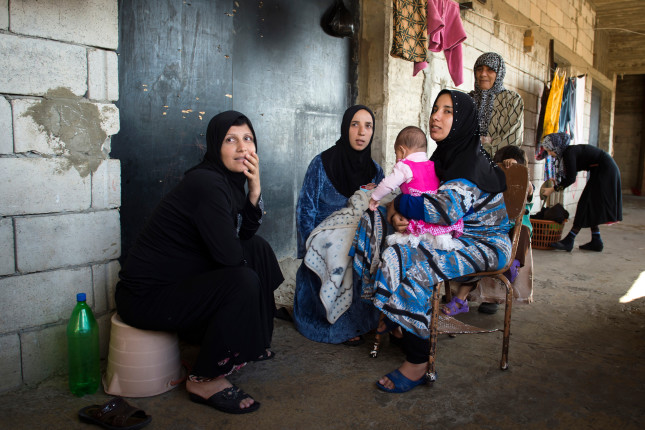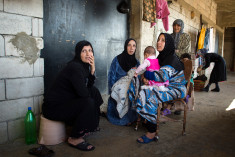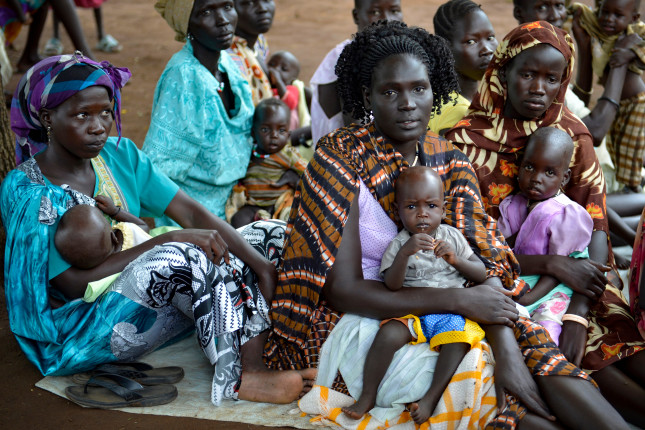-
Accessing Justice for Gender-Based Violence in Humanitarian Settings
December 8, 2021 By Sarah B. Barnes
Gender-based violence (GBV) is a global epidemic rooted in gender inequality and an imbalance in power dynamics. All persons are at risk of violence because of their gender or perceived gender. Women and girls—including transgender women and girls—experience disproportionate gender-based violence, and this violence is even more prevalent among women and girls who have been forcibly displaced.

Gender-based violence (GBV) is a global epidemic rooted in gender inequality and an imbalance in power dynamics. All persons are at risk of violence because of their gender or perceived gender. Women and girls—including transgender women and girls—experience disproportionate gender-based violence, and this violence is even more prevalent among women and girls who have been forcibly displaced.
Even when GBV is reported, the pandemic has created further challenges for authorities trying to identify and prosecute those accused.
Globally, 1 in 3 women experience violence during their lifetime. In some humanitarian emergencies, however, more than 70 percent of women have experienced GBV, and an estimated 1 in 5 displaced women will experience sexual violence. Due to conflict, persecution, and natural disasters, an estimated 68.5 million people have been displaced, including 25.4 million refugees, 3.1 million asylum seekers, and 40 million internally displaced persons. The catastrophic number of displaced persons, coupled with the increased risk of GBV in these settings, threatens the lives of millions of women and girls, as well as global progress toward gender equity and empowerment.
Even in the best situations, accessing justice for survivors of violence is extremely difficult. In humanitarian settings, the process—from initial reporting to full legal justice—is rife with obstacles. Displacement disrupts social support systems, removes connections to services and familiar legal avenues, and inserts added stress and economic insecurity, which are key drivers of violence. The threats to displaced persons take many forms, including intimate partner violence, rape as a weapon during conflict, early and forced marriage, and human trafficking.
Internally displaced persons (IDPs)—individuals who are forced to flee their homes, but who do not cross an international border—are especially vulnerable. Unlike refugees, they are not eligible for protections under international law. IDPs, often women and children, are also at a heightened risk of being trapped in areas of conflict or being used as weapons of war, compared to refugees.
Studies show that the COVID-19 pandemic has exacerbated already high levels of GBV, and lockdowns and restrictions on movement have made reporting even more difficult. Even when GBV is reported, the pandemic has created further challenges for authorities trying to identify and prosecute those accused. While violence is often perpetrated by family members, traffickers, or other displaced persons, documentation also shows abuse from national migration administrations, peacekeeping forces, and humanitarian staff, which further exacerbates the balance of power and distrust in protection systems.
Reporting and Legal Systems
COVID-19 restrictions have further hindered access to legal services and justice for survivors.
Experts have always predicted that the rate of gender-based violence is much higher than what is actually reported, due to the structural barriers survivors face when seeking justice. Intimate partner violence (IPV), often called domestic violence, is the most common form of gender-based violence, but it has been estimated that less than 40 percent of women who suffer from IPV seek help. Prior to the pandemic, screening of refugees in Cox’s Bazar in Bangladesh suggested that 1 in 4 women and girls experienced GBV and 80 percent of those cases were IPV. Since camps were locked down, reporting of violence has decreased by 50 percent. However, since lockdowns have made it even more difficult to report acts of violence, service providers are confident that IPV and other forms of gender-based violence are actually on the rise. COVID-19 restrictions have further hindered access to legal services and justice for survivors. Lockdowns, quarantines, curfews, and other restrictions on movement have limited survivors’ access to police, legal aid, and social services, as well as counseling, safe shelters, medical treatment, and sexual and reproductive health services. In the Democratic Republic of Congo, for example, authorities had to suspend an investigation into mass rape in South Kivu, as well as postpone trials of individuals charged with sexual violence crimes, due to COVID-19 restrictions.
In addition to fear of their abuser(s), victims of GBV also often have a general distrust of the systems designed for their protection. For displaced populations, a general mistrust of legal systems, limited courts and legal staff, and difficulty navigating legal systems can leave survivors of violence with minimal to no means of legal justice. For survivors with irregular legal or citizenship status, seeking justice through formal legal systems can be perilous, potentially resulting in detention or deportation.
Displaced communities also often create and place value on informal justice systems, where legal decisions are negotiated through community, religious, or family leaders. However, even in these informal systems, the rights and best interests of survivors are rarely upheld.

Progress toward Gender Equity and the Elimination of Violence against Women and Girls
Repeatedly shining a light on the blatant inequity faced by women and girls is a first step toward the elimination of violence.
International declarations like the 1993 Declaration on the Elimination of Violence against Women and the 2000 Resolution on Women, Peace, and Security have helped secure positive steps forward for the world’s women and girls, but more must be done within these frameworks to recognize both refugees and internally displaced persons. Other international guidelines, like the United Nations Population Fund’s Minimum Standards for Prevention and Response to Gender-Based Violence in Emergencies, have worked to create concrete mechanisms to put these high-level commitments into action. However, implementation of these guidelines is notoriously difficult and has become increasingly challenging in the COVID-19 era. In order to truly capture the effects of the pandemic on the global increase of GBV, it is important to continue efforts to collect quantitative and qualitative data to illuminate these impacts, Gender inequality is the root cause of gender-based violence. Without progress toward the ultimate goal of gender equity, women and girls will not be safe from violence. Repeatedly shining a light on the blatant inequity faced by women and girls is a first step toward the elimination of violence. In agreement with the Resolution on Women, Peace and Security, it is imperative to incorporate a gender perspective into peacekeeping operations, include adequate contract and accountability mechanisms to prevent sexual violence, and to promote gender diversification of the peacekeeping troops, military observers, and civilian police.
Investing in improved reporting and services for survivors of violence is also paramount to improving justice for survivors. Phone hotlines, text messaging, and videoconferencing can be useful tools to engage survivors, but in humanitarian emergency settings, access to phones and the internet may be limited or even restricted by local authorities. This forces humanitarian service providers to be even more innovative in their efforts to engage survivors. In Jordan, organizations have turned women-only safe spaces into private phone booths where Syrian refugees can confidentially call and speak to GBV counselors at any time without risk of exposure. In Lebanon, refugee women suggested holding GBV awareness-raising sessions in small, socially distanced groups.
It is ultimately up to national and local governments, donors, international organizations, nongovernmental organizations, and communities to continue the focus on displaced populations during this devastating time of COVID-19. There must be increased investment in innovative programming to improve the reporting of gender-based violence and the treatment and protection of survivors, as well as a revamping of the legal justice system and efforts to improve awareness of legal status and protections.
Sources: Block, K. et al (2019), International Rescue Committee, Refugees International, Stark, L. et al. (2021), United Nations, United Nations Human Rights Office of the High Commissioner, United Nations University, World Health Organization.
Photo Credits: Syrian refugees sit inside an abandoned construction site in Saida, Lebanon. Richard Juilliart/Shutterstock; South Sudanese refugees at Kule Refugee Camp in Gambella, Ethiopia. Richard Juilliart/Shutterstock.
Topics: conflict, Covid-19, Dot-Mom, GBV, gender, global health, human rights, humanitarian, security
 A Publication of the Stimson Center.
A Publication of the Stimson Center.





